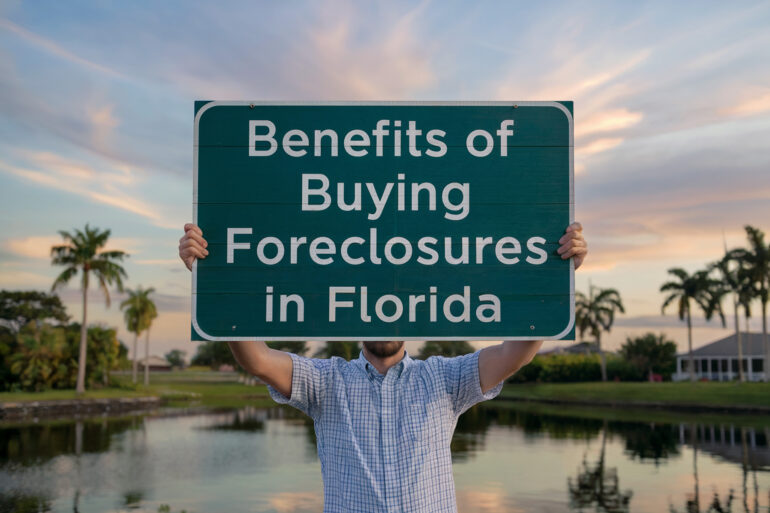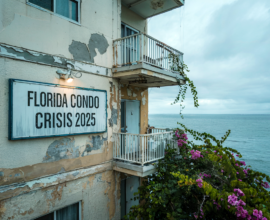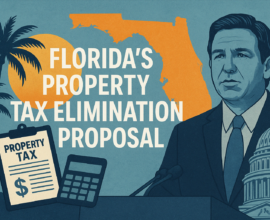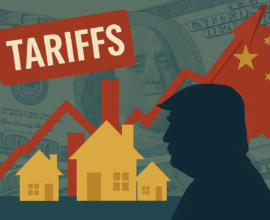Benefits of Buying Foreclosures in Florida
Introduction
Florida remains one of the most attractive states for real estate investment, particularly in the foreclosure market. As of Q3 2024, one in every 971 housing units in Florida was in foreclosure, making it one of the most active foreclosure markets in the United States.
This high activity level provides opportunities for novice and experienced investors to capitalize on distressed properties at significantly reduced prices.
The state’s foreclosure properties — homes repossessed by lenders after mortgage defaults — span a wide variety of asset types, from single-family residences and condominiums to commercial buildings and vacant lots.
These properties are often sold at a fraction of their market value, offering substantial profit potential. In addition, Florida’s lack of a state income tax, its booming tourism economy, and steady population growth create a favorable environment for real estate investors.
In July 2024 alone, Florida recorded 2,339 foreclosure starts, trailing only California in nationwide foreclosure activity. The diversity of property types and the state’s economic fundamentals make Florida a unique and lucrative market for those seeking strategic investment opportunities.
Pro tip: You can get Grants to Buy Foreclosed Homes.
Lower Purchase Prices: Unlocking Value in Florida’s Foreclosure Market
One of the most compelling reasons to invest in Florida foreclosures is the opportunity to purchase properties well below market value. On average, foreclosed properties in Florida sell at 20-30% discounts compared to traditional market listings. These savings vary depending on factors such as location, property condition, and market dynamics.
- Competitive Markets: In high-demand areas like Palm Beach and Broward County, discounts tend to be smaller, often closer to 10%, as these regions remain highly desirable for buyers.
- Opportunistic Markets: In Gulf Coast areas such as Naples-Marco Island and Punta Gorda, where properties have longer market times — averaging 95-100 days — buyers often find deeper discounts due to reduced competition.
Why Foreclosures Are Discounted:
- Banks and financial institutions aim to minimize holding costs and remove non-performing assets from their balance sheets. This urgency often leads to pricing strategies that favor quick sales.
- REO (Real Estate Owned) properties, which remain in a bank’s inventory for extended periods, are typically listed at reduced prices to attract buyers.
- Properties sold at county foreclosure auctions are offered on a cash-only basis, enabling buyers to negotiate for significant discounts due to the reduced buyer pool and the risks of buying “sight unseen” due to the nature of the sales.
For example: Consider a property in Tampa with a market value of $400,000. A 20% discount typical for foreclosures would reduce the purchase price to $320,000. These $80,000 savings can be allocated toward renovations, reducing overall costs and increasing the property’s resale or rental potential.
Financing Options:
- REO properties are often eligible for financing directly from the selling bank, making them more accessible for investors who cannot pay cash upfront.
- County foreclosure auction purchases require cash at the time of sale but can be refinanced after obtaining title through private lenders, often up to 100% of the after-repair value (ARV).
Investing in discounted foreclosure properties allows buyers to secure immediate equity, creating a solid foundation for future profits.
High Return on Investment: How Florida Foreclosures Pay Off
Investing in foreclosures offers the potential for high returns, thanks to a combination of discounted purchase prices, renovation opportunities, and strong rental demand. Here’s how Florida foreclosures can maximize your profits:
Renovation Opportunities
Foreclosed properties often require repairs, but renovation costs in Florida are relatively affordable compared to other markets. Current estimates include:
- General renovation costs: $15-60 per square foot.
- Whole-house renovations: $17-68 per square foot.
- Kitchen and bathroom remodels: $130-290 per square foot.
By strategically planning renovations, investors can significantly increase a property’s value. For example, updating a foreclosed home in Jacksonville with $30,000 in renovations could boost its appraised value by $70,000, creating immediate equity.
Market Appreciation Trends
Florida’s real estate market shows consistent appreciation, particularly in urban centers and coastal areas. While weather events may affect some regions, overall property values in popular areas like Miami, Tampa, and Orlando remain robust. These cities benefit from solid job markets, steady population growth, and thriving tourism sectors.
- Miami: Premium pricing persists, with properties in high-demand neighborhoods often appreciating faster than the state average.
- Tampa: A growing metropolitan area with a balanced mix of affordability and long-term growth potential.
- Orlando: Supported by year-round tourism, the market remains resilient even in the face of economic fluctuations.
Rental Demand and Cash Flow Potential
Florida’s rental market is another critical factor driving high ROI for investors. The state’s popularity among tourists, retirees, and job-seekers ensures consistent demand for both short-term and long-term rentals.
Key Rental Statistics:
- Miami-Miami Beach: Median rent for a one-bedroom unit is $2,600, making it a lucrative market for short-term rentals.
- Orlando: Median rents for one-bedroom units stand at $1,570, driven by its proximity to Walt Disney World and Universal Studios.
- Jacksonville: With a median rent of $1,270, the city offers affordability and growth potential, making it an excellent choice for long-term rental strategies.
Case Study: An investor in Orlando purchased a foreclosed single-family home for $200,000. After investing $40,000 in renovations, the property appraised at $300,000. The investor rented the home for $2,000 per month, generating an annual rental income of $24,000. Factoring in property management fees and other costs, the investor still achieved a net ROI of over 8% annually.
Critical Considerations for Maximizing ROI
- Market Selection: Focus on areas with strong job growth and rental demand, such as Miami and Tampa.
- Strategic Renovations: Prioritize cost-effective upgrades that significantly boost property value, such as kitchen remodels or energy-efficient installations.
- Effective Management: Partner with experienced property managers to optimize rental income and minimize vacancies.
By carefully selecting properties and planning renovations, investors can achieve strong cash flow and long-term appreciation, making Florida foreclosures a smart addition to any portfolio.
Florida’s foreclosure market continues to offer varied opportunities for strategic investment
Diverse Opportunities Across Florida
Florida’s foreclosure market presents a rich tapestry of investment opportunities, each region offering distinct advantages shaped by local economic drivers, population trends, and recent market dynamics. Understanding these regional variations is crucial for investors seeking to maximize their returns in the state’s diverse real estate landscape.
East Coast Markets: Stability Amid Demand
- Miami-Miami Beach: As a vibrant hub for luxury tourism and international investment, Miami leads the rental market with median rents of $2,600 for one-bedroom units. Despite a modest 2.3% decrease year-over-year, the area remains a top choice for investors targeting high-income renters or short-term rentals.
- Fort Lauderdale: Known for its blend of upscale living and accessibility, Fort Lauderdale offers strong rental demand, with median rents at $2,000. The city has seen a 5.3% year-over-year decline in rental rates, signaling potential opportunities for investors to buy properties at lower prices while still capitalizing on consistent demand.
East Coast markets continue to demonstrate remarkable stability and resilience, particularly in the major metropolitan areas. Miami-Miami Beach stands as the region’s cornerstone, commanding the state’s highest rental rates[AC1] [AC2] , and the area maintains its position as a premier destination for both international investors and domestic buyers. Fort Lauderdale complements Miami’s luxury market with a more accessible price point. Its blend of coastal living and urban amenities continues to attract steady investment interest.
Central Florida Markets: Economic Growth and Tourism
- Orlando: As the world’s theme park capital, Orlando benefits from year-round tourism. Median rents for one-bedroom units stand at $1,570, driven by its proximity to attractions, like Walt Disney World. Investors can explore both short-term vacation rentals and long-term rental strategies here.
- Tampa: Known for its affordability and steady growth, Tampa balances accessibility and economic opportunity. With median rents at $1,600, the city appeals to both families and professionals, offering stable returns for rental property investors.
Central Florida’s markets tell a compelling story of economic diversification and sustained growth. Orlando, anchored by its world-renowned tourism industry, gives the city a unique position as a global tourist destination and provides investors with multiple strategic options, from traditional long-term rentals to vacation properties. Tampa has emerged as a balanced market alternative, supported by a growing job market and an expanding urban core. Jacksonville rounds out the central Florida opportunities with more affordable entry points, showing median rents of $1,270 and notably, a positive 1.6% year-over-year growth rate.
Emerging West Coast Opportunities along the Gulf Coast
Recent hurricanes, including Milton and Helene, have significantly impacted Florida’s Gulf Coast, creating both challenges and opportunities for investors:
- Naples-Marco Island: Properties in this area currently stay on the market for an average of 100 days, with a median listing price of $749,999. Approximately 17.5% of listings have undergone price reductions, offering potential for buyers who can navigate post-hurricane challenges.
- Punta Gorda: This market shows a median listing price of $397,000, with extended listing times averaging 95 days. The combination of reduced competition and motivated sellers makes this region attractive for investors willing to renovate and adapt.
The Gulf Coast region presents a particularly timely opportunity following the impact of Hurricanes Milton and Helene. Naples-Marco Island, traditionally known for its luxury market, now shows a significant percentage of its current 5,648 listings cutting their prices, which signals potential opportunities for strategic investors. Punta Gorda reflects similar trends at a more accessible price point, offering an ideal entry point for investors willing to navigate post-hurricane market conditions.
North Florida and Panhandle Markets: Government Stability and Tourism Growth
- Tallahassee: The state capital shows strong rental growth with median one-bedroom rents at $970 and a notable 4.3% year-over-year increase, driven by government employment and multiple universities.
- Panama City: Currently among the top 20 challenging markets for property sales, offering opportunities for strategic investors in post-hurricane recovery areas.
- Crestview-Fort Walton Beach-Destin Corridor: Premium beach destinations with strong tourism appeal, though currently experiencing extended market times due to recent storm impacts.
North Florida and the Panhandle present their own unique investment landscape, characterized by different market dynamics than their southern counterparts. Tallahassee shows promising rental market metrics. The city’s stable government employment base and large student population from multiple universities create consistent rental demand. Panama City and the broader Panhandle region have entered a transitional phase following recent hurricane impacts. The challenging market, combined with ongoing recovery efforts, creates possibilities for investors prepared to navigate post-storm market conditions. The Crestview-Fort Walton Beach-Destin corridor, while facing some current market headwinds, maintains its appeal due to its pristine beaches and strong tourism base.
These northern markets often offer more affordable entry points compared to central and southern Florida locations, with the added advantage of lower population density and less competition from institutional investors. However, they also face unique challenges, including seasonal tourism patterns different from those in South Florida and recovery needs from recent storm impacts.
Inland Markets: Resilience and Stability
Inland locations, such as The Villages and Palm Coast, offer safer alternatives for those looking to avoid the risks associated with coastal properties. These areas benefit from lower exposure to natural disasters while maintaining steady demand from retirees and long-term tenants.
Pro Tip: Diversify your investments by balancing high-yield opportunities in coastal regions with stable options in inland markets. This strategy helps mitigate risks while maximizing returns.
Further Florida Foreclosure Investment Market Insights
Key West, despite its unique challenges with a median listing time of 105 days and a median home price of $1.27 million, illustrates the complexity of coastal market dynamics. Recent data shows only eight listings experiencing price increases against 224 price reductions, suggesting a market in transition that may offer strategic entry points for well-positioned investors.
The recent hurricane impacts have also led to a notable shift in market preferences, with inland areas gaining increased attention from both investors and homebuyers. This trend reflects a growing awareness of weather-related risks and insurance considerations, particularly in coastal regions. Areas further from the coast, while perhaps lacking the premium appeal of beachfront locations, often offer more stable long-term investment prospects with lower insurance costs and reduced exposure to natural disasters.
This regional diversity allows investors to tailor their strategies to specific market conditions and risk tolerances. Whether pursuing the high-end coastal markets of Miami-Dade, the tourism-driven opportunities in Orlando, or the emerging value plays along the Gulf Coast, Florida’s foreclosure market continues to offer varied opportunities for strategic investment. The key lies in understanding these regional nuances and aligning investment strategies with local market dynamics and recovery patterns.
This dynamic market environment creates multiple pathways for investors to generate returns from foreclosure properties, whether through short-term vacation rentals or traditional long-term leases.
Addressing Common Concerns About Foreclosure Investments
While foreclosure investments are often lucrative, they come with unique risks that can deter inexperienced buyers. Understanding and addressing these concerns is crucial for success.
1. Hidden Costs
Foreclosed properties frequently require repairs, which can increase the total investment. Common issues include:
- Structural damage from neglect or vandalism.
- Outdated systems (e.g., plumbing, electrical).
- Cosmetic upgrades needed to make the property marketable.
Solution:
- Conduct a thorough property inspection before purchase, if possible.
- Allocate 10-15% of the purchase price as a contingency for unexpected repair costs.
2. Title Issues
Some foreclosed properties come with unresolved liens, unpaid taxes, or other encumbrances that can complicate ownership transfer.
Solution:
- Use title search services, like those offered by PropertyOnion.com, to identify potential issues before bidding.
- Work with a real estate attorney to resolve liens or other legal complications post purchasing.
3. Financing Challenges
Not all foreclosures are eligible for traditional financing, particularly properties sold at county auctions requiring cash payments.
Solution:
- Prepare liquid funds for auction purchases or partner with private lenders to secure financing quickly.
- For REO properties, explore financing options with the selling bank, which often provides competitive rates.
4. Market Volatility
Solution:
- Invest in inland properties or areas less prone to severe weather events.
- Obtain comprehensive insurance coverage, factoring in potential premium increases for high-risk regions.
How PropertyOnion.com Helps Mitigate Risks
PropertyOnion.com offers a range of tools and resources designed to simplify the foreclosure investment process:
- Title Searches: Identify liens or encumbrances before bidding.
- Educational Resources: Learn about the foreclosure market through courses and guides.
- Detailed Property Listings: Access comprehensive data on properties, including auction dates and specifications.
By leveraging these tools, investors can make informed decisions, reducing risks while maximizing potential returns.
Simplified Auction Process
Florida’s foreclosure auction system has become more accessible and transparent, thanks to digital advancements and the growing availability of online platforms. Understanding how the process works is essential for investors looking to navigate this dynamic market effectively.
How Foreclosure Auctions Work
- County Auctions:
- Properties are sold to the highest bidder, often requiring immediate cash payment upon winning.
- Auctions typically involve properties with unresolved liens or unpaid judgments, which must be addressed by the buyer post-purchase.
- Online Auctions:
- Platforms like PropertyOnion.com provide investors with access to the data of a wide range of properties across Florida counties.
- These platforms offer critical information, such as auction schedules, bidding rules, and property details, enabling investors to make informed decisions without attending in-person events.
Advantages of the Auction Process
- Speed of Transactions: Foreclosure auctions allow buyers to close deals quickly, often within days.
- Competitive Pricing: Properties sold at auction are frequently priced below market value, providing immediate equity for buyers.
- Transparency: Online platforms offer detailed property descriptions, lien information, and title data, reducing uncertainty.
Post-Auction Financing
- Properties purchased at auctions can often be refinanced later, up to 100% of their after-repair value (ARV), freeing up cash for renovations or additional investments.
- For Real Estate Owned (REO) properties, financing options are often available through the selling bank, providing flexibility for buyers who prefer not to pay cash upfront.
Tips for Success
- Conduct thorough due diligence using tools like title searches and property inspections before bidding.
- Familiarize yourself with county auction rules, as they can vary by jurisdiction.
- Use platforms like PropertyOnion.com to stay updated on upcoming auctions and to access comprehensive market data.
- By mastering the auction process and leveraging the available resources, investors can minimize risks while capitalizing on Florida’s foreclosure opportunities.
Investors can unlock significant value by leveraging the unique benefits of Florida’s foreclosure market, addressing common risks, and staying attuned to market trends.
Rental Market Potential
Florida’s rental market continues to demonstrate robust fundamentals driven by the state’s unique combination of year-round tourism, steady population growth, and diverse economic opportunities. This dynamic market environment creates multiple pathways for investors to generate returns from foreclosure properties, whether through short-term vacation rentals or traditional long-term leases.
Short-Term Rentals
- Orlando: Home to globally renowned attractions like Walt Disney World, Orlando remains a leader in short-term rental demand. Vacation properties here boast high occupancy rates and premium nightly rates during peak seasons.
- Miami Beach: With its international appeal and luxury tourism, Miami Beach properties can command top-dollar rental prices, particularly in the short-term market.
- Tampa: Business travelers and event attendees drive steady demand for short-term accommodations in Tampa, offering a lucrative opportunity for investors targeting urban professionals.
The short-term rental market shows particular strength in key tourist destinations across the state. Orlando stands at the forefront of this sector, with its proximity to world-famous attractions, like Walt Disney World and Universal Studios, creating consistent demand throughout the year. The city’s rental market reflects this steady tourism influence, maintaining stable rates with median one-bedroom rents at $1,570. Despite a 7.1% year-over-year decrease, the market continues to offer strong potential for vacation rental strategies.
Miami Beach represents another powerhouse in the short-term rental sector, drawing visitors with its iconic Art Deco Historic District and vibrant nightlife. The area commands premium rates, with median one-bedroom rents reaching $2,600, the highest in the state. While experiencing a modest 2.3% year-over-year decrease, Miami Beach’s international appeal and luxury tourism sector continue to support strong rental returns. The broader Miami-Miami Beach market demonstrates remarkable resilience, particularly in premium locations that attract both domestic and international visitors.
Tampa has carved out its own niche in the rental market, balancing affordability with strong demand. With median one-bedroom rents at $1,600, the city attracts a diverse mix of renters, from young professionals to seasonal visitors. Tampa’s growing business convention sector and dynamic events calendar create additional opportunities for short-term rental strategies, particularly in well-located properties near the city center.
Long-Term Rentals
Florida’s metropolitan areas continue to show robust demand for long-term rentals:
- Miami: Median rent for a one-bedroom unit is $2,600, reflecting the city’s desirability among professionals and retirees alike.
- Jacksonville: Known for its affordability and rising demand, Jacksonville offers one-bedroom rentals at a median price of $1,270, making it an attractive option for buy-and-hold investors.
- Fort Lauderdale: A stable rental market with median rents of $2,000, despite a slight decline in year-over-year growth.
The long-term rental market shows equally compelling opportunities across different regions. Fort Lauderdale, despite experiencing a 5.3% year-over-year decline, maintains healthy median rents. The city’s blend of beach lifestyle and urban amenities continues to attract long-term renters seeking quality housing options.
Jacksonville emerges as a particularly interesting market for long-term rental strategies, showing a positive 1.6% year-over-year growth in rental rates. The city offers an attractive combination of affordability and growth potential. This positive trend suggests increasing demand from long-term renters, potentially driven by job growth and population expansion in the region.
Specific areas have emerged as strongholds for different rental strategies. The Villages continues to attract retirees seeking community-focused living environments, creating steady demand for long-term rentals. Bonita Springs, strategically positioned between Fort Myers and Naples, appeals to working professionals and offers strong potential for traditional rental arrangements. Englewood and Palm Coast have developed their own appeal, particularly among retirees seeking peaceful environments with accessible amenities.
The recent impacts of Hurricanes Milton and Helene have added new considerations to rental market strategies, particularly along the Gulf Coast. These events have influenced both property availability and insurance costs, factors that investors must carefully consider when developing rental strategies. However, this situation has also created opportunities for investors who can navigate the current market conditions and provide quality rental housing in affected areas.
Insurance market changes have become a critical factor in rental property operations, with some companies exiting Florida entirely while others have significantly increased rates. This shift has implications for rental property investors, who must factor these costs into their operational budgets while maintaining competitive rental rates. Properties in inland areas, with potentially lower insurance costs, may offer advantages for certain rental strategies.
The combination of strong tourism demand, population growth, and evolving market conditions continues to create varied opportunities in Florida’s rental market. Success in this sector requires careful consideration of location, property type, and target tenant demographics, along with a thorough understanding of regional market dynamics and operational costs.
Maximizing Rental Income
- Renovate Strategically: Focus on upgrades that enhance tenant appeal, such as energy-efficient appliances or modern finishes.
- Understand Market Trends: Stay informed about regional rental trends to set competitive prices and minimize vacancies.
- Effective Property Management: Hiring a property manager can optimize rental operations, ensuring timely maintenance and tenant satisfaction.
By aligning their investments with Florida’s rental market dynamics, investors can generate consistent cash flow and long-term appreciation.
Conclusion
Florida’s foreclosure market in 2024 offers unparalleled opportunities for investors seeking to maximize their returns. From discounted purchase prices and robust rental demand to investor-friendly tax policies, the state remains a top destination for real estate entrepreneurs. However, success requires careful planning, due diligence, and strategic execution.
The diversity of Florida’s regions — ranging from the luxury markets of Miami Beach to the emerging opportunities in inland cities — provides options for every investment strategy. Platforms like PropertyOnion.com play a crucial role in simplifying the foreclosure process, offering tools and resources that empower investors to make informed decisions.
Investors can unlock significant value by leveraging the unique benefits of Florida’s foreclosure market, addressing common risks, and staying attuned to market trends. Whether you’re a seasoned professional or new to real estate, Florida’s dynamic foreclosure market offers a pathway to financial success.








